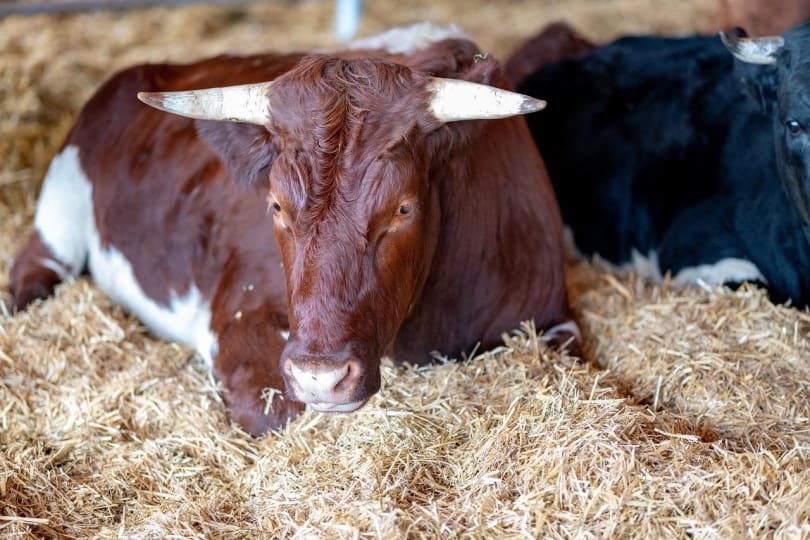The Pinzgauer is an Austrian cattle breed that is both beautiful and purposeful on the farm. If you are looking for a cattle breed on a small-scale farm, these are useful cattle to consider.
Since they serve practically any purpose you can think of, they are favorable in most situations. However, their ability to be acquired can be a different story depending on where you are in the world. Let’s find out more about this cattle breed to see if they are compatible with your setup.

Quick Facts About Pinzgauer Cattle
| Breed Name: | Pinzgauer |
| Place of Origin: | Austria |
| Uses: | Meat, milk |
| Bull (Male) Size: | 2,000+ pounds |
| Cow (Female) Size: | 1,000 to 1,600 pounds |
| Color: | Chestnut and white |
| Lifespan: | 16 to 18 years |
| Climate Tolerance: | Cold/heat hardy |
| Care Level: | Moderate |
| Production: | Dual-purpose |
| Temperament: | Docile, motherly |

Pinzgauer Cattle Origin
The Pinzgauer cattle breed originated in Pinzgau, Austria, where it was derived from ancient species dating back to 800 BC. The entire idea behind creating this breed was to make a hearty, infestation-resistant cow that could thrive in weather conditions and rough terrain.
The pronunciation of the breed is “pins-gow-r.” However, they have gone by several other names as well, including:
- Pongauer
- Salzburger Schecken
- Mölltaler
- Brixentale
- Tiroler Rückenschecken
- Traunsteiner
- Berchtesgadner
While they have a variety of monikers, after they were introduced into cattle associations in the 19th century, the Pinzgauer became the most widely used name for the breed.
The chestnut coloration is the most prevalent type, although there is a black coloring variation as well that was more easily found in the past. The chestnut color has remained very prevalent, making any black coloration incredibly rare these days.
These are known as lucky cows, according to farmers. This high output, dual-purpose breed thrives in Austria today, encompassing areas like Romania, Slovak Republic, and Slovenia. In these areas, it is widely revered for being an incredibly well-producing cattle breed that serves multiple purposes on the farm.

Pinzgauer Cattle Characteristics
Pinzgauer cattle are beautiful muscular farm animals that were built to withstand the elements. These cows have an impressive stance and they are instantly recognizable if you know anything about the industry.
Farmers would describe Pinzgauer cattle as being calm and easy to maintain. Bulls can be quite a challenge (as most of them are), and cows are much more relaxed.
These cows are also known for being docile. They are generally very calm and quiet creatures who don’t resist handling from keepers. Because of their disposition, it makes them incredibly easy to milk and corral.
Uses
The Pinzgauer is a dual-purpose cow that is used for both meat and dairy production. Sizable and strong, bovines weigh between 1,000 and 1,600 pounds. Bulls, on the other hand, weigh over 2,000 pounds.
Outside of Europe, these cattle are mainly used for meat production and not dairy. Western cultures have replaced cattle such as these with ultra-high milk producers like the Holstein. However, and their native lands, this dual-purpose breed still upholds the standard for both.
These cows make impeccable mothers who take outstanding care of their young if you are into cattle breeding. So, you can also use them to raise calves.
The Pinzgauer cow can live up to 18 years in captivity. However, it will be significantly less if you use them for meat production.
Appearance & Varieties
These Austrian beauties have quite a noticeable pattern that sets them apart from other cattle. The chestnut and white colors of the Pinzgauer cow are charming and vibrant. As we mentioned above, there are black variations, but they are incredibly rare and not recognized by any association.
This breed is incredibly stout, and its fur is tightly bound, making it a suitable shield for insects to prevent infestation. Their sturdy composition helps them survive all sorts of pasture conditions.

Population & Distribution
This breed is unfortunately on a steady population decline. In fact, some sources say the population decreases by 10% every year.
So, while it is not impossible to find them, as they are widespread in many regions, it might get harder and harder as the years pass. However, there is a national association in the US for the Pinzgauer with hefty distribution throughout the states and Canada. They are still a moderately prevalent breed in Europe. So, you have a much better chance of finding them if you were on that side of the globe.
Habitat
Pinzgauer cattle do very well with pasture living. They are compatible with numerous terrain, being hearty and weather tolerant.
These cattle require shelter from outdoor elements, commercial feed, and a fresh water source. However, they equally enjoy grazing and should always have access to foliage when possible.
Aside from giving them basic, everyday necessities, these cows do not require special treatment or particular setups. They need enough land to graze, and they should be easy to manage.

Are Pinzgauer Cattle Good for Small-Scale Farming?
Depending on your geographical location, these cattle can make excellent additions to small-scale farming, permitting that you have more than one. The social animals require a herd, so you should have at least a pair or more.
These cows are exceptionally tolerant to weather in the rain, permitting you to have the proper shelter and diet plan for them. If you are interested in the Pinzgauer cattle, you can look locally to see if it is a feasible breed to own in your area.
Related cattle reads:
Featured Image Credit: RobbyFo, Pixabay
